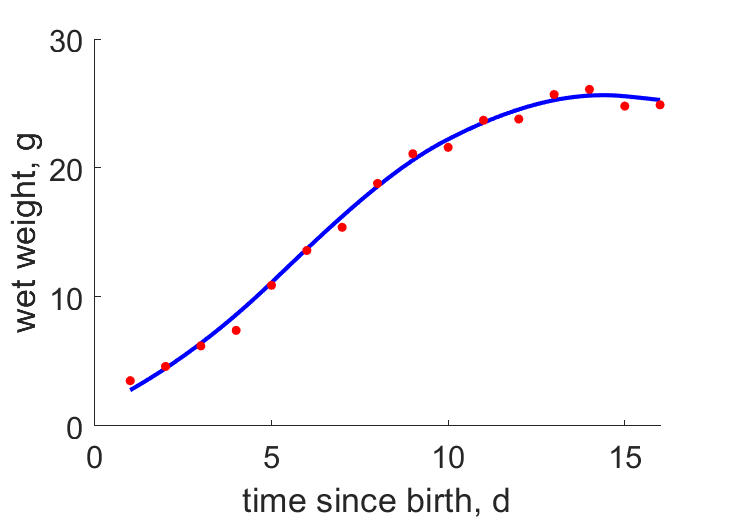Predictions & Data for this entry
| Model: std | climate: B, Cfa, Dfa | migrate: | phylum: |
| COMPLETE = 2.5 | ecozone: THn | food: biCi, biHs | class: |
| MRE = 0.020 | habitat: 0iTht, 0iThh | gender: Dg | order: |
| SMSE = 0.001 | embryo: Tnpf | reprod: O | family: |
Zero-variate data
| Data | Observed | Predicted | (RE) | Unit | Description | Reference |
|---|---|---|---|---|---|---|
| ab | 14 | 14.14 | (0.009858) | d | age at birth | AnAge |
| tx | 16 | 16.16 | (0.01016) | d | time since birth at fledging | Berg1913 |
| tp | 48 | 47.43 | (0.01195) | d | time since birth at puberty | guess |
| tR | 365 | 365 | ( 0) | d | time since birth at 1st brood | AnAge |
| am | 4234 | 4204 | (0.006995) | d | life span | AnAge |
| Ww0 | 1.95 | 1.745 | (0.1049) | g | initial wet weight | avibase |
| Wwb | 1.3 | 1.3 | (0.0001434) | g | wet weight at birth | AnAge |
| Wwi | 26.1 | 26.56 | (0.01762) | g | ultimate wet weight | Berg1913 |
| Ri | 0.03288 | 0.03272 | (0.004855) | #/d | maximum reprod rate | AnAge |
Uni- and bivariate data
| Data | Figure | Independent variable | Dependent variable | (RE) | Reference |
|---|---|---|---|---|---|
| tW |  | time since birth | wet weight | (0.0288) | Berg1913 |
Pseudo-data at Tref = 20°C
| Data | Generalised animal | Haemorhous mexicanus | Unit | Description |
|---|---|---|---|---|
| v | 0.02 | 0.02715 | cm/d | energy conductance |
| p_M | 18 | 687 | J/d.cm^3 | vol-spec som maint |
| k_J | 0.002 | 0.02786 | 1/d | maturity maint rate coefficient |
| k | 0.3 | 0.2975 | - | maintenance ratio |
| kap | 0.8 | 0.9364 | - | allocation fraction to soma |
| kap_G | 0.8 | 0.7984 | - | growth efficiency |
| kap_R | 0.95 | 0.95 | - | reproduction efficiency |
Discussion
- mod_1: v is reduced
- mod_1: food availability is taken variable in tW data
- mod_2: Pseudo-data point k is used, rather than k_J; Data set tp and parameter t_R are added, the latter replacing clutch interval t_N. Postnatal T is based on PrinPres1991, see get_T_Aves. See further the revision page, theme puberty
Bibliography